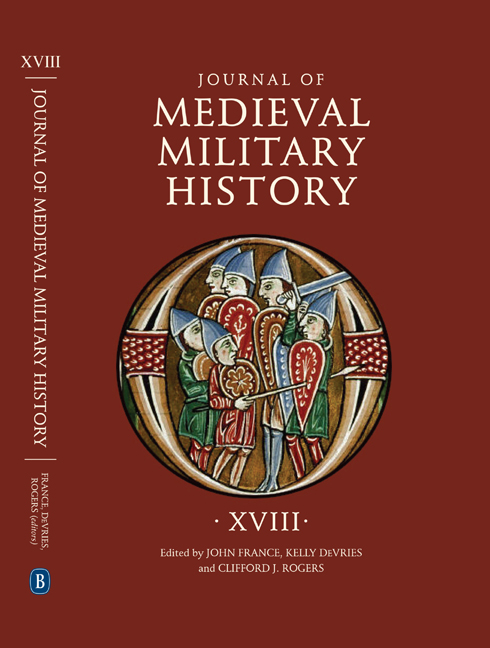Book contents
- Frontmatter
- Contents
- List of Illustrations
- 1 The Eastern Campaigns of King Henry II of Germany, 1003–17
- 2 Peace, Popular Empowerment and the First Crusade
- 3 The Transformation of Naval Warfare in Scandinavia during the Twelfth Century
- 4 Auxiliary Peoples and Military Reform on Hungary’s Western Frontier in the Thirteenth Century
- 5 What Types of Sources Did Medieval Chroniclers Use to Narrate Battles? (England and France, Twelfth to Fifteenth Centuries)
- 6 Experimental Tests of Arrows against Mail and Padding
- 7 Four Misunderstood Gunpowder Recipes of the Fourteenth Century
- 8 The Earliest Middle English Recipes for Gunpowder
- 9 Horses and Horsemen in Fifteenth-Century Siege Warfare, with Particular Reference to the Later Hundred Years War
- 10 Supplying the Army: The Siege of Pisa, 1499
- List of Contributors
- Journal of Medieval Military History 1477–545X
3 - The Transformation of Naval Warfare in Scandinavia during the Twelfth Century
Published online by Cambridge University Press: 06 October 2020
- Frontmatter
- Contents
- List of Illustrations
- 1 The Eastern Campaigns of King Henry II of Germany, 1003–17
- 2 Peace, Popular Empowerment and the First Crusade
- 3 The Transformation of Naval Warfare in Scandinavia during the Twelfth Century
- 4 Auxiliary Peoples and Military Reform on Hungary’s Western Frontier in the Thirteenth Century
- 5 What Types of Sources Did Medieval Chroniclers Use to Narrate Battles? (England and France, Twelfth to Fifteenth Centuries)
- 6 Experimental Tests of Arrows against Mail and Padding
- 7 Four Misunderstood Gunpowder Recipes of the Fourteenth Century
- 8 The Earliest Middle English Recipes for Gunpowder
- 9 Horses and Horsemen in Fifteenth-Century Siege Warfare, with Particular Reference to the Later Hundred Years War
- 10 Supplying the Army: The Siege of Pisa, 1499
- List of Contributors
- Journal of Medieval Military History 1477–545X
Summary
Following their conversion to Christianity and the subsequent expansion of the royal administrative apparatus, the Scandinavian realms of Denmark, Norway and Sweden oversaw significant and long-lasting changes to their political, social and economic structures; their military institutions were, of course, no exception. Due to the central role that seas, coastlines and waterways had in the region, naval warfare was particularly important in Scandinavia. One of the quintessential military institutions was the leiðangr, or the naval levies, which had played a central role during the military campaigns of the Viking Age. This article will analyze the transformation of naval warfare in twelfth-century Scandinavia from a holistic, comparative perspective. To this end, several complementary aspects of contemporaneous naval warfare will be explored, such as the aristocratization of the military institutions, the emergence of new types of large warships, and tactical innovations that radically changed the way war at sea was waged in high medieval Scandinavia.
The Scandinavian realms underwent considerable changes to their political institutions, social structures and economic exploitation models during the twelfth and thirteenth centuries, and the military institutions are no exception. The relatively decentralized military model of the Viking Age, which relied on peasant levies for large expeditions, was gradually replaced by smaller aristocratic fleets that in turn used the increasingly larger income of the aristocratic strata in order to build much larger warships. These considerable changes in military organization and shipbuilding, therefore, changed naval warfare in Scandinavia to a substantial degree.
The transformation of naval warfare during the twelfth century has never been considered from a holistic point of view. For example, in order to understand the changes in tactics, both the changes in the military institutions and the emergence of new types of warships should be taken into account. These three aspects of warfare – military organization, shipbuilding innovations and tactical approaches – can be discerned from a number of written and material sources. While the legal codes of the twelfth and thirteenth centuries have often been used when researching the changes in the military institutions, primary material that describes both shipbuilding and tactics has rarely been taken into account.
- Type
- Chapter
- Information
- Journal of Medieval Military HistoryVolume XVIII, pp. 81 - 98Publisher: Boydell & BrewerPrint publication year: 2020

